CCR3
-
Official Full Name
chemokine (C-C motif) receptor 3 -
Overview
The protein encoded by this gene is a receptor for C-C type chemokines. It belongs to family 1 of the G protein-coupled receptors. This receptor binds and responds to a variety of chemokines, including eotaxin (CCL11), eotaxin-3 (CCL26), MCP-3 (CCL7), MCP-4 (CCL13), and RANTES (CCL5). It is highly expressed in eosinophils and basophils, and is also detected in TH1 and TH2 cells, as well as in airway epithelial cells. This receptor may contribute to the accumulation and activation of eosinophils and other inflammatory cells in the allergic airway. It is also known to be an entry co-receptor for HIV-1. This gene and seven other chemokine receptor genes form a chemokine receptor gene cluster on the chromosomal region 3p21. Alternatively spliced transcript variants have been described. -
Synonyms
CCR3;chemokine (C-C motif) receptor 3;CKR3;CD193;CMKBR3;CC-CKR-3;MGC102841;C-C chemokine receptor type 3;CCR-3;C-C CKR-3;OTTHUMP00000209745;b-chemokine receptor;CC chemokine receptor 3;eosinophil eotaxin receptor;eosinophil CC chemokine receptor;Chemokine (C C motif) receptor 3;Chemokine (CC) receptor 1 like 2;Eosinophil CC chemokine receptor 3;Macrophage inflammatory protein 1 alpha receptor like 2;OTTHUMP00000164718;OTTHUMP00000209746;OTTHUMP00000209747;OTTHUMP00000209748;CD193 antigen
Recombinant Proteins
- Human
- Rat
- Mouse
- Cynomolgus
- Rhesus macaque
- Macaca mulatta
- Dog
- Chlorocebus Aethiops
- Macaca fascicularis
- E.coli
- HEK293
- Wheat Germ
- Mammalian Cells
- In Vitro Cell Free System
- GST
- Flag
- Non
- His
- Avi
- Fc
Background
What is CCR3 Protein?
CCR3 gene (C-C motif chemokine receptor 3) is a protein coding gene which situated on the short arm of chromosome 3 at locus 3p21. The protein encoded by this gene is a receptor for C-C type chemokines. It belongs to family 1 of the G protein-coupled receptors. This receptor binds and responds to a variety of chemokines, including eotaxin (CCL11), eotaxin-3 (CCL26), MCP-3 (CCL7), MCP-4 (CCL13), and RANTES (CCL5). It is highly expressed in eosinophils and basophils, and is also detected in TH1 and TH2 cells, as well as in airway epithelial cells. This receptor may contribute to the accumulation and activation of eosinophils and other inflammatory cells in the allergic airway. It is also known to be an entry co-receptor for HIV-1. The CCR3 protein is consisted of 355 amino acids and CCR3 molecular weight is approximately 41.0 kDa.
What is the Function of CCR3 Protein?
CCR3 is a G-protein-coupled receptor that is mainly expressed in eosinophils, basophils, mast cells, and helper T cell type 2 (Th2). It is responsive to several C-C chemokines, including eotaxin (CCL11), Eotaxin-3 (CCL26), MCP-3 (CCL7), MCP-4 (CCL13), and RANTES (CCL5). The function of CCR3 is mainly related to chemotaxis, which plays a key role in regulating the migration and localization of immune cells, especially in allergic diseases such as asthma and atopic dermatitis, by promoting the accumulation and activation of eosinophils and other inflammatory cells in tissues such as the airway. In addition, CCR3 is also considered to be one of the co-receptors of HIV-1, which is involved in the cell entry process of the virus.
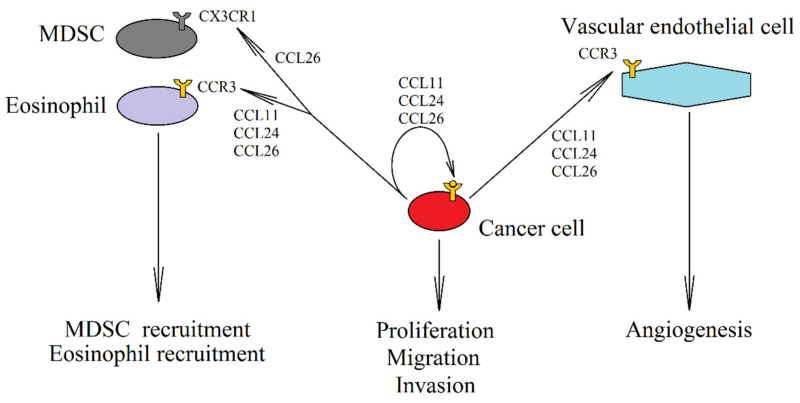
Fig1. The role of eotaxins in cancer. (Jan Korbecki, 2020)
CCR3 Related Signaling Pathway
CCR3 is an important G-protein-coupled receptor that is expressed on a variety of immune cells and is involved in a variety of signal transduction processes by binding to different ligands. When CCR3 binds to its ligands such as eotaxin (CCL11), Eotaxin-3 (CCL26), MCP-3 (CCL7), MCP-4 (CCL13), and RANTES (CCL5), it triggers the activation of intracellular signaling pathways that affect cell migration, activation, and function. In terms of signal transduction, the activation of CCR3 can promote the activation of Gq-PLC-Ca2+ and MAPK-P38-ERK signaling pathways. Activation of these pathways is essential for recruitment and degranulation of immune cells such as eosinophils in tissues, as well as the release of inflammatory mediators, which play a key role in the pathogenesis of allergic diseases.
CCR3 Related Diseases
CCR3 is a key chemokine receptor whose abnormal expression or function is associated with a variety of diseases. It is expressed in a variety of immune cells such as eosinophils, basophils, mast cells, and T helper cell type 2 (Th2), making it play an important role in the immune response. CCR3 is strongly associated with allergic diseases such as asthma and atopic dermatitis, exacerbating the inflammatory response by promoting the accumulation and activation of inflammatory cells in tissues such as the airway. In addition, CCR3 has been implicated in other immune-related inflammatory diseases, including multiple sclerosis, rheumatoid arthritis, atherosclerosis, transplant rejection, and autoimmune diseases. In the field of oncology, CCR3 has also been implicated in the development of certain cancers, possibly affecting the behavior of immune cells in the tumor microenvironment.
Bioapplications of CCR3
Because CCR3 plays a role in the activation and migration of immune cells such as eosinophils, it is a potential target for the treatment of allergic diseases such as asthma and atopic dermatitis. By developing CCR3 antagonists, it is possible to reduce the accumulation of inflammatory cells in tissues such as the airway, thereby alleviating allergy symptoms. Based on studies of the structure and function of CCR3, scientists are developing new small molecule drugs and biologics designed to specifically modulate CCR3 signaling pathways to treat related diseases. Changes in the expression level of CCR3 in some diseases may serve as biomarkers of disease status and help in the diagnosis of disease and the monitoring of therapeutic response.
Case Study
Case Study 1: Xin Chang, 2016
Fibroblast-like synoviocyte (FLS) invasion in synovium appears one of the features of OA, but expression and function of CCR3 on FLS remain uninvestigated. This study explored it. Enzymatically dispersed synovial tissue cells were analyzed by flowcytometry. Primary cultured FLS isolated from OA synovium were challenged and the expression of CCR3, eotaxin-1 and matrix metalloproteinase (MMP)-9 was determined by quantitative real-time PCR (qPCR) and ELISA. Approximately 4.5% dispersed OA synovial tissue cells are CCR3+ cells. Eotaxin-1 induced up to 5.8 and 7.2-fold increases in the expression of MMP-9 mRNA and protein, respectively following 12h incubation with FLS, which was inhibited by antagonist of CCR3 SB328437 and an inhibitor of ERK U0126, indicating that action of eotaxin-1 on FLS seemed via CCR3 and ERK signaling pathway.
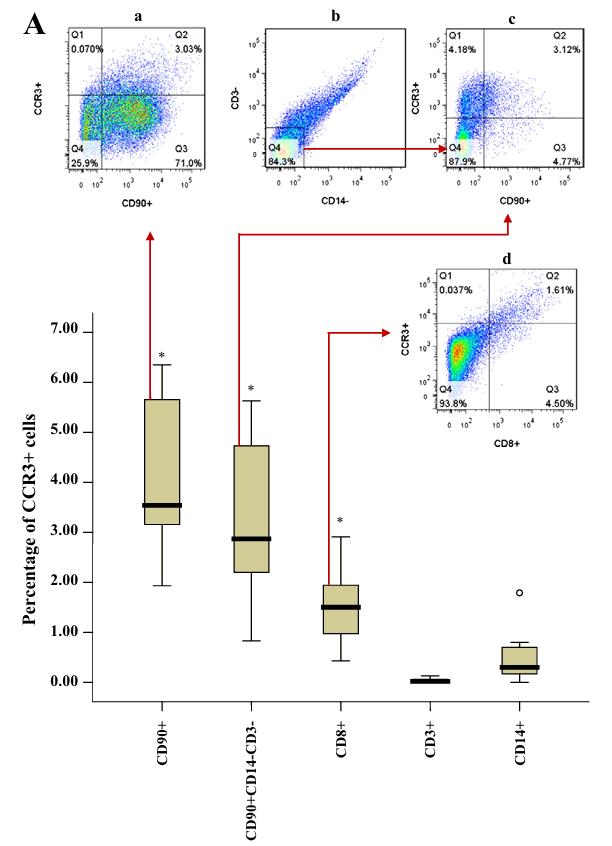
Fig1. Percentage of CCR3+ cell populations from total dispersed synovial tissue cells.
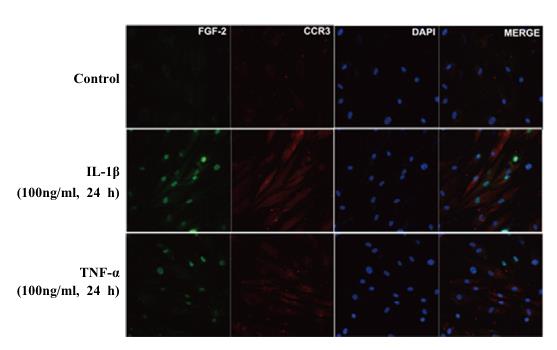
Fig2. Expression of CCR3 in human FLS.
Case Study 2: Aaruni Khanolkar, 2013
Recent reports have provided conflicting evidence on the stability of CCR3 expression on the surface of basophils. This study aimed to independently evaluate the diagnostic usefulness of CCR3 as a surrogate marker of basophil activation and function. Researchers examined the correlative relationship between CCR3 expression on the surface of donor basophils and histamine release after donor basophils were treated with agonistic antibodies directed against the high-affinity IgE-Fc receptor and serum samples from 80 individuals displaying symptoms of chronic urticaria (CU). The results showed that CCR3 was significantly downregulated on donor basophils treated with the agonistic antibody. CCR3 downregulation was also observed on donor basophils incubated with more than 40% of CU-patient serum samples with HRA scores less than or equal to 10.
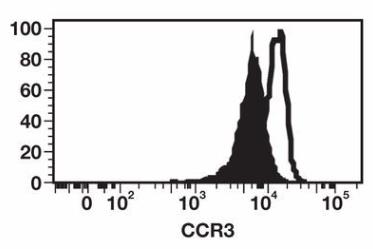
Fig3. Representative histograms depict CCR3 expression patterns on the surface of basophils.
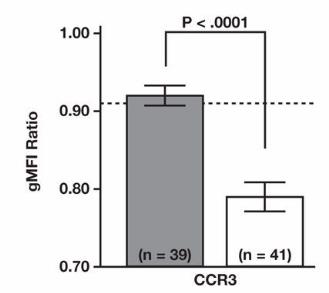
Fig4. Bar graphs depict the fold change in MFI (gMFI ratio) for CCR3 on donor basophils.
Quality Guarantee
High Purity
.jpg)
Fig1. SDS-PAGE (CCR3-0294H)
.
.jpg)
Fig2. SDS-PAGE (CCR3-0691H)
Involved Pathway
CCR3 involved in several pathways and played different roles in them. We selected most pathways CCR3 participated on our site, such as Chemokine receptors bind chemokines,Chemokine signaling pathway,Class A/1 (Rhodopsin-like receptors), which may be useful for your reference. Also, other proteins which involved in the same pathway with CCR3 were listed below. Creative BioMart supplied nearly all the proteins listed, you can search them on our site.
| Pathway Name | Pathway Related Protein |
|---|---|
| GPCRs, Class A Rhodopsin-like | SSTR2,GPR18,GPR68,GPR3,GPR85,ACKR4,GPR20,AGTR2,DRD3,OPN1SW |
| Class A/1 (Rhodopsin-like receptors) | S1PR5B,LPAR1,CCK,NPFFR2,DRD4,GPR132,CCL35.1,ADORA3,OPN4,SSTR3 |
| GPCR ligand binding | GPBAR1,EMR1,XK,CXCR6,PTGDR2,CCK,CRH,ADRA2B,AMCF-II,RLN3 |
| Cytokine-cytokine receptor interaction | ACVR1BA,IL5,IL17RB,TSLP,IL22RA1,PRL,TGFBR1,IL12RB1,CXCL2,ACKR3B |
| Chemokine receptors bind chemokines | ACKR4,CCBP2,CXCL13,CCL35.1,CCL19A.2,CCR1,CCRL2,CCR7,CCL35.2,CXCR7B |
| G alpha (i) signalling events | CCR7,OXGR1A.1,OPN1LW2,PTGDR2,GPR55A,NMS,OPN1MW2,FPR-RS6,APLN,SSTR2 |
| Chemokine signaling pathway | GNG13,GNG10,CCL3L1,CCL16,CCL7,RELA,CRK,AKT2,ARRB2,Ccl21a |
| GPCR downstream signaling | PNOC,RAMP2,RHOL,TAS2R13,INSL5,PROKR2,RHOGA,RGS14,CCR9,GPBAR1 |
Protein Function
CCR3 has several biochemical functions, for example, C-C chemokine receptor activity,chemokine receptor activity,protein binding. Some of the functions are cooperated with other proteins, some of the functions could acted by CCR3 itself. We selected most functions CCR3 had, and list some proteins which have the same functions with CCR3. You can find most of the proteins on our site.
| Function | Related Protein |
|---|---|
| C-C chemokine receptor activity | CCR9,CCR6,CCR1,CCR10,GPR75,CCR5,CCBP2,CCR1L1,CCR7,CCR6A |
| chemokine receptor activity | CXCR4B,PRLH2R,GPR17,CCBP2,CXCR3.1,RGRA,CMKLR1,CCR5,CCR6A,CCR12A |
| protein binding | REST,C3orf62,SUGP1,RUFY3,CD48,ZNF750,LCA5,C3orf52,LRPAP1,POMGNT1 |
Interacting Protein
CCR3 has direct interactions with proteins and molecules. Those interactions were detected by several methods such as yeast two hybrid, co-IP, pull-down and so on. We selected proteins and molecules interacted with CCR3 here. Most of them are supplied by our site. Hope this information will be useful for your research of CCR3.
CCL11
Resources
Gene Families
Research Area
Related Services
Related Products
References
- Sugaya, M; et al. Chemokines and Skin Diseases. ARCHIVUM IMMUNOLOGIAE ET THERAPIAE EXPERIMENTALIS 63:109-115(2015).
- Makita, N; Hizukuri, Y; et al. IL-10 enhances the phenotype of M2 macrophages induced by IL-4 and confers the ability to increase eosinophil migration. INTERNATIONAL IMMUNOLOGY 27:131-141(2015).



